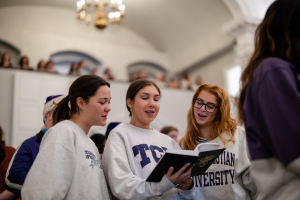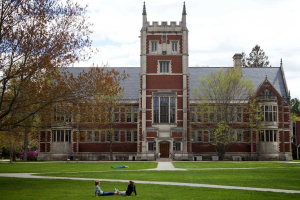Top 10 Best Optometry Colleges in the US
To guarantee that you get a top-notch education if you want to become an optometrist, you must locate a reputable optometry college. You can browse through ... read more...some of the best optometry colleges in the US to find the ideal one for you.
-
The most extensive and cutting-edge eye health education, research, and patient care are found at Indiana University School of Optometry, with a focus on outreach to the most vulnerable populations. Its main goals are to prioritize eye health, advance the field of vision through research, increase access to services for all those in need, and prepare the next generation of eye health professionals through state-of-the-art curricula.
The official optometric organization acknowledged by the Council on Higher Education Accreditation is the Accreditation Council on Optometric Education of the American Optometric Association, which has granted accreditation to the IU School of Optometry. All requirements and standards established by the Association of Schools and Colleges of Optometry must be fulfilled by admitted students.
The four-year professional Doctor of Optometry (O.D.) degree program at Indiana University School of Optometry covers all theoretical and fundamental aspects of vision science in addition to the clinical and practical aspects of optometry.
Students work on clinical cases integrating topics from biology, disease, genetics, optics, vision science, and physiology-pharmacology from the first day. You can take part in research with our faculty members on a variety of topics, such as disease, color vision, early diabetes detection, and optical imaging, during the summer following your first year.
Depending on the degree you wish to pursue, the School of Optometry's application procedure, deadlines, and requirements change. While all other programs only offer fall admission, those applying for the thesis-based Master of Science program may do so for the fall, spring, or summer semester.
Every optometry degree program has different prerequisites and courses that are specific to it. Please visit the Indiana University School of Optometry's current optometry bulletin to view these in full detail.
Founded: 1951
Address: 800 E. Atwater AvenueBloomington, Indiana 47405, US
Phone: 812 855 4447
Email: iubopt@indiana.edu
Acceptance Rate: 83%
Annual Degrees Awarded: 84
SAT Score: 1,220–1,320
Tuition:
- Resident: $24,359 - $34,194
- Nonresident: $33,761 - $46,730
Website: https://optometry.iu.edu/index.html
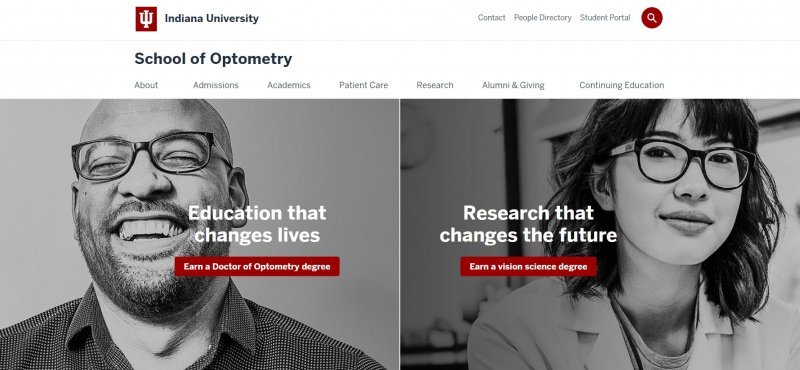
Screenshot of https://optometry.iu.edu/index.html Video by Indiana University -
The only public optometry school in Texas, the University of Houston College of Optometry, comes in second on the list of the best optometry colleges in the US. Situated in the largest city in Texas and the fourth largest in the US, the campus is home to the largest medical center globally.
The school trains students for primary care roles in five distinct community clinic settings in Houston, Dallas, and Fort Worth, Texas, as well as modern clinical practice. With the help of our network of training facilities across the country and our on-site ambulatory surgical center, the University of Houston College of Optometry also offers advanced training in medical and surgical eye care.
The buildings, which total about 120,000 square feet, comprise the Health 1 and the J. Davis Armistead. The health sciences library, student study rooms, clinical training spaces that include outpatient clinics, an ambulatory surgical center, telehealth services, and more are all part of these state-of-the-art training facilities.
Research labs supporting biomedical research related to the eye, ranging from clinical trials to cellular and molecular disease mechanisms, are also available at the University of Houston College of Optometry.
Beginning in the fall semester of their second year, students enrolled in the Doctor of Optometry program will receive patient care training as well as various clinical services through UH Health - Eye Care Center.
Graduate students in Physiological Optics or Combined programs are prepared for careers in basic and clinical vision sciences education and research, which may lead to positions in academia, business, or other professional settings.
Advanced Practice Fellowships and Resident Training programs are offered by the University of Houston College of Optometry as well as several affiliated external sites. These courses are intended to give optometrists advanced clinical expertise in a particular field. Training programs focus on research, teaching, and hands-on patient care.
The Optometry Admissions Test (OAT) is strongly preferred by the College of Optometry, which requires submission of entrance exam results. Scores from the MCAT, PCAT, DAT, and GRE are also accepted.
Founded: 1952
Address: 4401 Martin Luther King Blvd, Houston, TX 77004, US
Phone: 713 743 2020
Email: uhco@central.uh.edu
Acceptance rate: 66%
Annual Degrees Awarded: 105
SAT Score: 1,160–1,240
Tuition:
- Texas Resident: $17,060
- Non-Resident: $29,252
Website: https://www.opt.uh.edu/
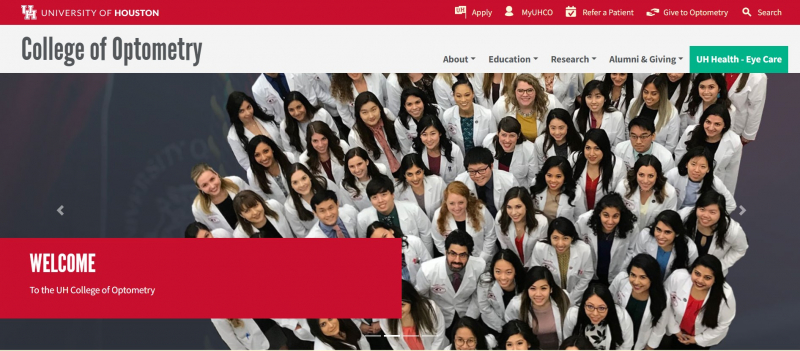
Screenshot of https://www.opt.uh.edu/ 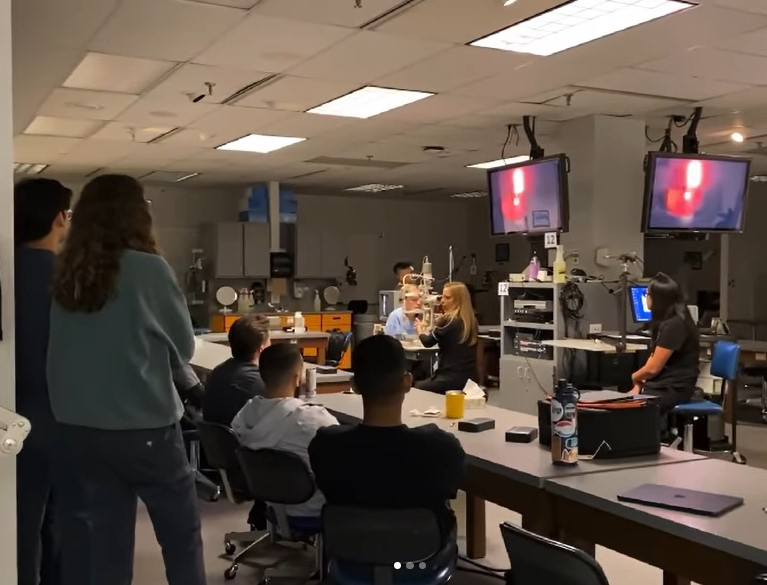
Screenshot of https://www.instagram.com/p/CyEtLWpRg7Q/?img_index=1 -
The next optometry school in the US is Pacific University College of Optometry. Pacific University holds full accreditation from both the Accreditation Council on Optometric Education (ACOE) of the American Optometric Association (AOA) and the Northwest Commission on Colleges and Universities (NWCCU).
A doctor of optometry program and residency programs in various specialties are provided by the College of Optometry. The institution also provides a Ph.D. and master's degree in vision science, which equips students to work in the ophthalmic field as researchers or teachers.
A four-year doctorate program in optometry is available at Pacific University College of Optometry. The curriculum far exceeds the strictest educational requirements of any state in the US or province in Canada, making graduates fully qualified to practice in North America.
A year more of structured education and advanced clinical experiences in cornea and contact lens care, geriatric optometry, low vision rehabilitation, ocular disease, pediatric optometry, primary eye care, co-management of refractive & ocular surgery, and vision therapy & rehabilitation are offered to optometric physicians through the Residency Programs.
The Master of Education/Visual Function in Learning (MEd/VFL) program, offered in partnership with Pacific's College of Education, is intended to give optometrists specialized study to qualify them as vision consultants to primary, secondary, and even higher education providers and organizations. This includes being knowledgeable about how reading and learning are impacted by vision.
Students at Pacific University College of Optometry immediately begin to acquire practical experience. Students get hands-on outreach experience and give care to a diverse patient population during the first semester of their first year. They will have worked with a variety of patients in several clinic rotations by the time they graduate.
The following elements are necessary for applicants to be considered at Pacific University College of Optometry.
- Application of OptomCAS
- Additional Submission
- Two assessment letters
- Reputable GRE or OAT results
- It is highly recommended to spend ten hours under the direct supervision of an optometrist.
- Compliance with the English Language Proficiency Policy
- Performance of the Principal Role
- Conversation
Founded: 1921
Address: 2043 College Way, Forest Grove, OR 97116, US
Phone: 503 352 6151
Email: Pitkanen@pacificu.edu
Acceptance Rate: 92%
Annual Degrees Awarded: 88
SAT Score: 1,030–1,150
Tuition: $44,972
Website: https://www.pacificu.edu/optometry/
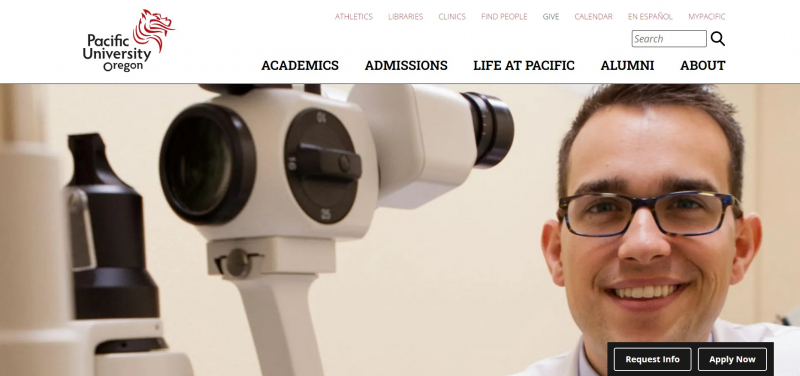
Screenshot of https://www.pacificu.edu/optometry/ Video by Pacific University -
The University of Missouri-St. Louis College of Optometry prepares the next generation of optometrists and vision researchers, promoting and delivering improved eye and health care for people across the nation. Experts in both optometry and vision science, its faculty is dedicated to giving students a challenging and thorough education.
Only twenty-two ASCO member schools in North America grant the Doctor of Optometry degree, and the College of Optometry oversees the sole professional training program for optometrists in the state of Missouri. Before being accepted into the four-year professional degree program, which is accredited by the Accreditation Council on Optometric Education (ACOE), more than 97% of the students at the institution had completed a bachelor's degree.
As crucial primary eye care providers in a successful healthcare delivery system, optometrists frequently hold leadership positions in their communities. The school is dedicated to exemplifying and cultivating an appreciation for the following principles as UMSL College of Optometry equips its graduates to carry out that responsibility with distinction.
The Doctor of Optometry (O.D.) degree requires four years of full-time study to complete. The College of Optometry offers six eight-week advanced clinical rotations, or externships, in the main optometric discipline during the fourth year of the professional program.
A rotation focused on ocular diseases and one in a sizable general clinical setting are required. Students must complete a minimum of two fourth-year rotations under the direction of College of Optometry faculty members located in St. Louis. Private optometric or ophthalmological practices allow externships.
The University of Missouri-St Louis College of Optometry requires the following materials from applicants.
- Use of OptomCAS
- Additional Application
- The Admission Test for Optometry (OAT)
- DAT, MCAT, or PCAT could be taken into
- A practicing optometrist is among the three recommendation letters.
- Official transcripts from colleges and high schools
Founded: 1967
Address: 1 University Blvd., 331 Marillac HallSt. Louis, MO 63121-4400
Phone: 314 516 5606
Email: optometry@umsl.edu
Acceptance Rate: 51%
Annual Degrees Awarded:
SAT Score: 1,040–1,140
Tuition:
- Missouri residents: $25,298
- No-residents: $41,759
Website: https://www.umsl.edu/divisions/optometry/index.html
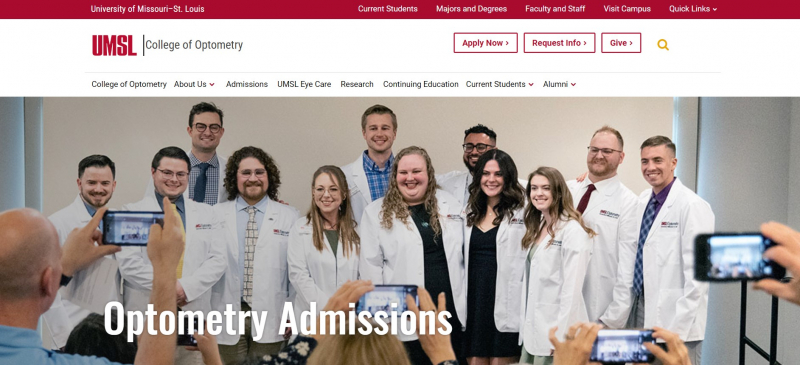
Screenshot of https://www.umsl.edu/divisions/optometry/admissions/index.html Video by Optometry UMSL -
Nova Southeastern University College of Optometry is another name in the list of the best Optometry Colleges in the US. It is a pioneer in the field of optometry research and education. Students have access to cutting-edge facilities and are taught by internationally recognized faculty.
The school is dedicated to giving students the know-how and abilities necessary to be successful in a cutthroat industry. They work for top hospitals and eye care clinics across the nation. The Accreditation Council on Optometric Education (ACOE) has granted full accreditation to the Doctor of Optometry program at Nova Southeastern University College of Optometry.
Optometric physicians are trained, educated, and prepared to practice at the highest standards of competence, ethics, and professionalism by the College of Optometry. NSU students are encouraged to engage in a wide range of activities as part of the multidisciplinary campus, including international mission trips, lifelong learning opportunities, and scholarly pursuits.
During their first year of study, optometry students acquire knowledge in basic biological sciences such as anatomy, physiology, microbiology, and neuroanatomy. They perform optometric examinations and study theoretical optics. They study ocular physiology and psychophysics in their second year when they start doing patient exams at NSU Health Eye Care.
In addition to learning about ocular diseases, contact lenses, and clinical medicine, third-year medical students also begin a practice management course. Along with practical experience and practice management concepts, they receive comprehensive instruction in secondary-tertiary eye care, specialized optometric care, and clinical education.
NSU-College of Optometry offers a one-year preparatory program, a five-year extended curriculum option, and a mini-MBA elective for optometry students. There are post-graduation options for several clinical residencies and a Master's in Clinical Vision Research (MSCVR).
Students are chosen by the College of Optometry using the following standards:
- A minimum of 90 semester hours of required coursework at a college or university with regional accreditation, 30 of which must be completed at a four-year institution.
- A GPA of at least 2.8 on a scale of 4.0
- A minimum OAT score of 300 (AA) and 290 (TS).
- Two recommendation letters from an optometrist and a science instructor
Founded: 1989
Address: 3300 S University Dr, Fort Lauderdale, FL 33328, US
Phone: 844 847 6021
Acceptance Rate: 76%
Annual Degrees Awarded: 107
SAT Score: 1,040–1,170
Tuition: $40,500
Website: https://optometry.nova.edu/
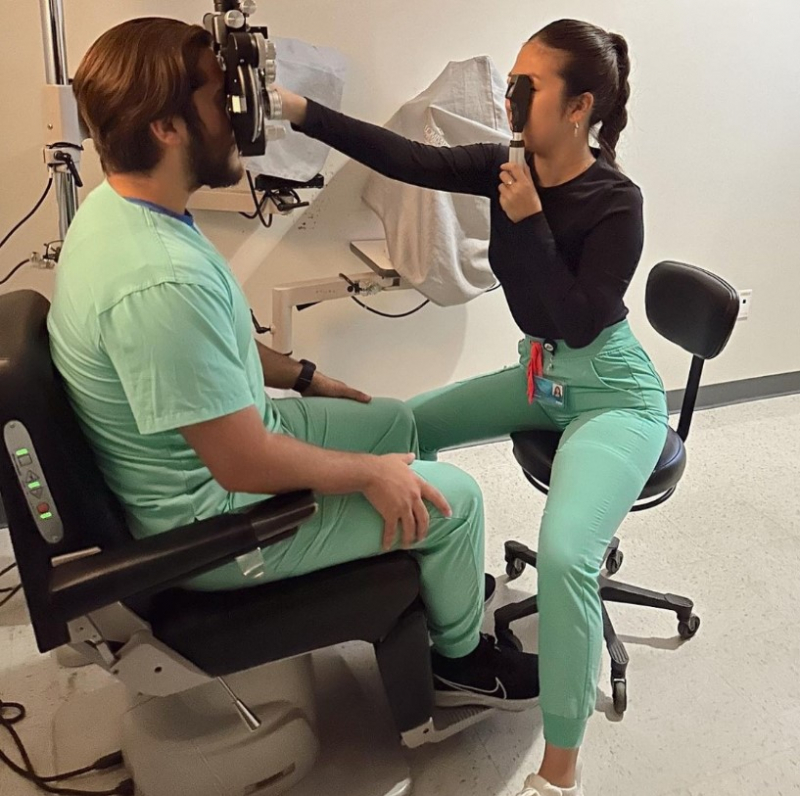
Screenshot of https://www.instagram.com/p/C0PNBC0r1Zx/ Video by Nova Southeastern University -
The University of California, Berkeley's Herbert Wertheim School of Optometry & Vision Science, popularly referred to as Berkeley Optometry, is an optometry school. In addition to a one-year residency program in clinical optometry specializations accredited by the ACOE, it offers a four-year graduate-level professional program leading to the Doctor of Optometry (OD) degree.
A comprehensive and demanding four-year clinical training program is provided by Berkeley Optometry. In years 1-2, students are assigned to preclinical training laboratories. In year 2, they take their first primary care exams in the spring semester.
The summer before year 3, they transition to full-time clinical training and provide direct patient care. As they progress through the four-year degree program, students receive increased clinical training and accountability. Fourth-year students spend almost all of their time in the clinic, compared to third-year students who visit it for roughly half of their time.
At Berkeley's Herbert Wertheim School of Optometry & Vision Science, You will learn about genetics, pharmacology, cell and molecular biology, epidemiology of eye disorders, and cutting-edge clinical technology. Along with primary care, you will also receive training in all clinical areas, including geriatrics, pediatrics, ocular disease, low vision, contact lenses, binocular disorders, and refractive surgery.
The Berkeley Optometry program places a strong emphasis on giving students extensive clinical experience in a range of environments. Two campus clinics, ten satellite clinics, seven VA clinics, and twenty-four outside training clinics across the nation are where the students receive their training and treat patients. There are 220,000 patient visits to these clinics annually overall.
During their study of optometry, OD students who are interested in research opportunities can apply for a summer program funded by the National Eye Institute (NIH). Post-OD students also have the option to apply to our Graduate Research Program or Residency Program.
Founded: 1923
Address: Minor Hall, 380 Minor Ln, Berkeley, CA 94720, US
Phone: 510 642 9537
Email: optometry-admissions@berkeley.edu
Acceptance Rate: 12%
Annual Degrees Awarded: 64
SAT Score:1,330–1,540
Total tuition per semester:
- CA Resident: $22,521.75
- Non-CA Resident: $28,644.25
Website: https://optometry.berkeley.edu/
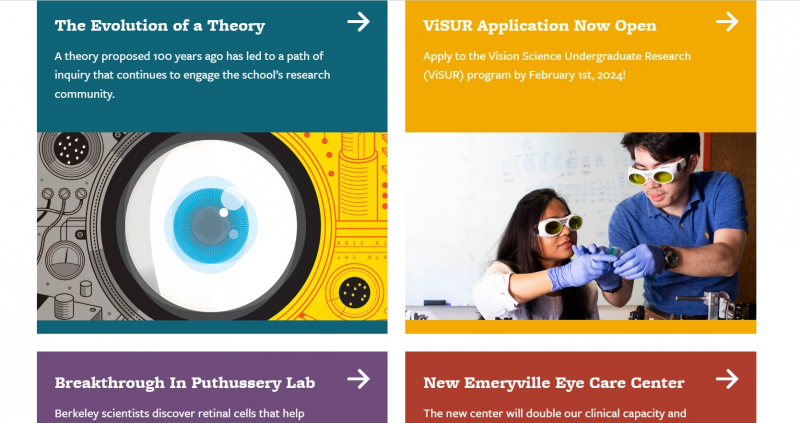
Screenshot of https://optometry.berkeley.edu/ Video by UC Berkeley School of Optometry & Vision Science -
One of the top universities in the country for the training of optometrists is Northeastern State University Oklahoma College of Optometry (NSUOCO). Students can receive a first-rate education in primary eye care thanks to the steadily evolving courses in basic and clinical sciences.
The four years of rigorous doctoral-level training required for the Doctor of Optometry degree equip students to function well as valuable members of an all-encompassing healthcare team. At the primary care level, the optometric physician is qualified to diagnose and treat a broad range of eye and vision issues. Furthermore, the optometrist acquires the ability to recognize and support a broad range of non-ocular systemic and physiological conditions.
The NSU Oklahoma College of Optometry is committed to providing excellent residency education, and one of its top priorities is resident training. The Oklahoma College of Optometry and associated external sites offer accredited residency programs. Every residency program is well-rounded with educational activities like teaching, literature review, case presentation, and research, with a strong focus on clinical practice.
The top-notch clinical education offered by NSUOCO offers a wealth of practical patient care experience. This underprivileged population receives cutting-edge eye care thanks to the partnership with the Cherokee Nation.
Utilizing the most advanced forms of new technology, including laser procedures, NSUOCO is known for training students to meet the demands of the future in vision care. Over forty thousand patients are seen by faculty, residents, and students each year.
The application procedure:
- To Apply, Go to OptomCAS
- The period for applications is July 1 through February 1
- Three recommendation letters
- $75 for an additional application fee
- Admission Test for Optometry (OAT)
- Interviewing procedure
Founded: 1979
Address: 1001 N Grand Ave, Tahlequah, OK 74464, US
Phone: 918-444-4000
Email: nsuopt@nsuok.edu
Acceptance Rate: 100%
Annual Degrees Awarded: 28
SAT Score: 930–1,040
Tuition:
- Oklahoma Resident: $20,700 - $27,354
- Non-Resident: $41,050 - $54,246
Website: https://optometry.nsuok.edu/
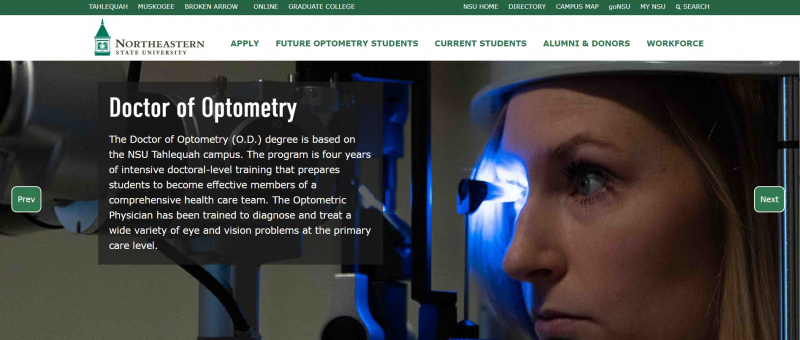
Screenshot of https://optometry.nsuok.edu/ Video by NSU Oklahoma College of Optometry -
A prestigious university in the United States offers an excellent optometry program at the Ohio State University College of Optometry. Its main objective is to graduate students who are skilled optometrists. Both the extensive clinical experiences and the didactic coursework make equal contributions.
2020 saw the opening of a brand-new clinic building on the Ohio State campus by the Ohio State University College of Optometry. This fantastic new facility is a pleasure for the students to learn in. In addition, the school has a preclinic teaching area with eighteen exam rooms, a 24/7 student injection room, and contact lens labs.
You will be exposed to every style of practice at Ohio State University College of Optometry, firsthand in our cutting-edge clinics, and then in-depth in specialty areas through our outstanding externship sites. Having research and clinical skills under one roof, you will get a well-rounded, all-inclusive optometric education that will enable you to pursue any career path you choose.
Through leadership development programs, individual career and personal coaching, and an extensive practice management curriculum, you will discover your ideal career path in optometry and be equipped with the resources you need to reach your practice's objectives.
With a focus on patient-based research, the Ohio State University Graduate Program in Vision Science offers Master of Science and Doctor of Philosophy degrees in a wide range of basic and clinical research opportunities. Future "best of the best" faculty members and vision scientists are being trained at the institution.
Applying to the PhD program does not require a Master's degree. After completing the first year of the Master's program, master's students who want to continue their education can apply to enroll in the Ph.D. program.
Founded: 1937
Address: 338 W 10th Ave, Columbus, OH 43210, US
Phone: 614 292 2647
Email: admissions@optometry.osu.edu
Acceptance Rate: 53%
Annual Degrees Awarded: 65
SAT Score: 1,340–1,380
Tuition:- Resident: $30,455
- Non-Resident: $51,511
Website: https://optometry.osu.edu/
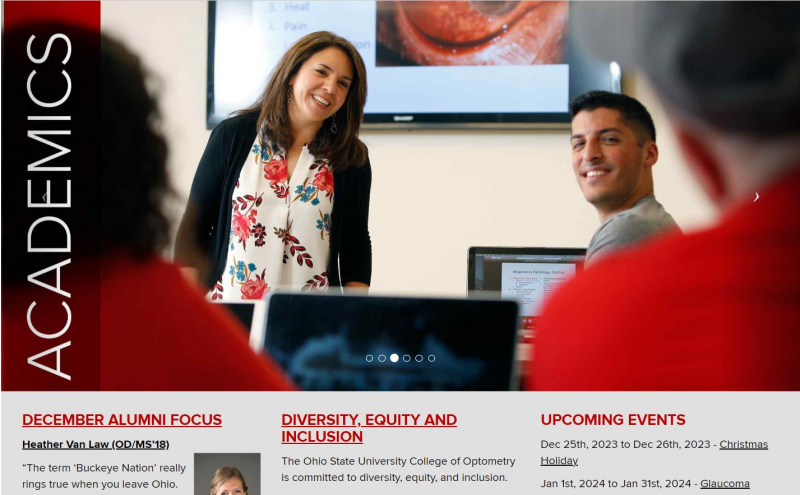
Screenshot of https://optometry.osu.edu/ 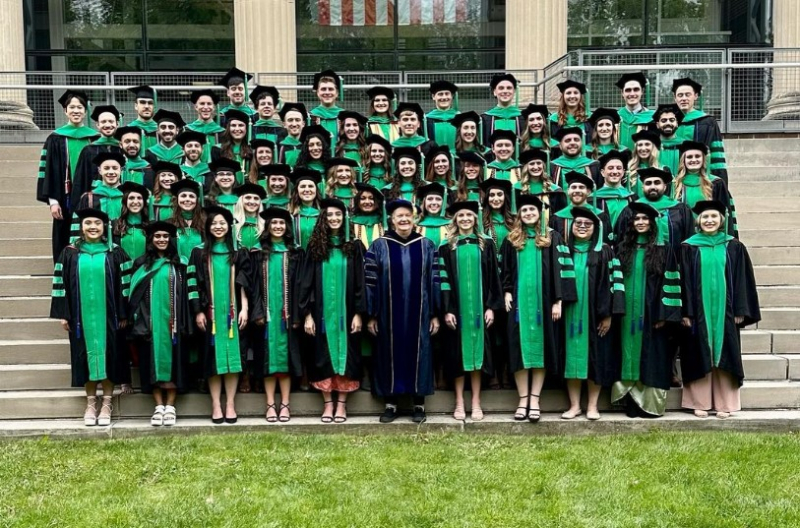
Screenshot of https://www.instagram.com/p/Cr7Lq2Rt7uK/ -
The University of the Incarnate Word Rosenberg School of Optometry strives for excellence in teaching, patient care, and vision research to educate and prepare the next generation of optometric leaders. This is accomplished in a setting dedicated to individual development within the frameworks of social justice, human dignity, and religion.
Not only are the teachers at the school highly skilled and eminent, but they also frequently stop by students in the hallways to check on them and see if they need assistance with anything right now. At UIWRSO, faculty accessibility has never been a problem, and the student-to-faculty ratio is approximately 6:1. Students at this school say that the faculty genuinely cares about their success and their ability to learn.
Your professional training will equip you to become the greatest optometrist and community leader you can be, in addition to teaching you about cutting-edge technology and providing hands-on experience in multiple community clinics of UIW Rosenberg School of Optometry. You will have the chance to reach personal heights at UIWRSO that you never would have imagined.
The 4-year curriculum that is required is based on the medical model and prioritizes clinical development and individualized attention. The curriculum combines classroom instruction with patient interaction, giving students early access to clinical training through community outreach initiatives, clinic rotations at the school, and externships in clinical settings both domestically and abroad.
Case-based seminars, grand rounds, problem-based learning, and the integration of instructional technologies like web-based learning, classroom performance systems, digital libraries, podcasts, and video conferencing are some of the curriculum's unique features.
The UIW Rosenberg School of Optometry offers opportunities for clinical research through its Summer Fellowship Training Program. Additionally, its Inter-Professional Education (IPE) program facilitates interaction with other medical and healthcare providers.
Rosenberg School of Optometry requires the following materials from applicants.
- Use of OptomCAS Application
- Additional Submission
- Exam for Admission to Optometry (OAT)
- It is possible to consider or accept the GRE, DAT, or MCAT.
- Two recommendation letters
- Statement about oneself
- 20 hours or more of minimum shadowing an OD in optometry
- Conversation
Founded: 2008
Address: 9725 Datapoint Dr, San Antonio, TX 78229, US
Phone: 210 883 1190
Email: optometry@uiwtx.edu
Acceptance Rate: 94%
Annual Degrees Awarded: 64
SAT Score: 910–1,020
Tuition: $40,300
Website: https://optometry.uiw.edu/
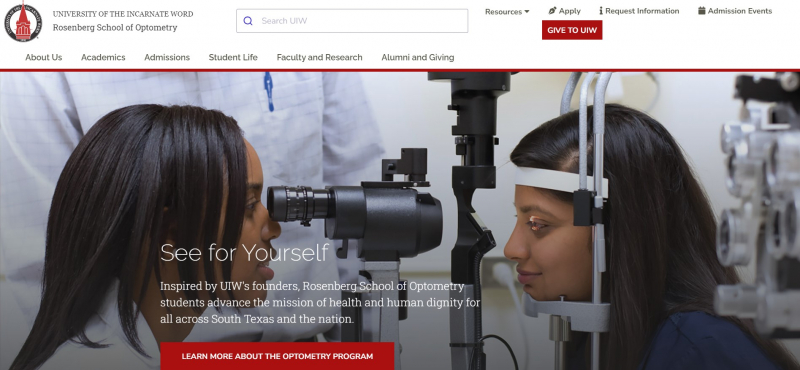
Screenshot of https://optometry.uiw.edu/ Video by UIW Admissions -
On the list of best optometry colleges in the US, UAB School of Optometry comes in last. It trains its students to be the leaders of the country in the discovery of new vision science principles and the provision of complete, evidence-based eye care. The Accreditation Council on Optometric Education has granted the UAB School of Optometry its accreditation.
Small classes, with a maximum of 55 students, are integrated into the extensive academic and clinical resource network provided by UAB. Students are taught by internationally renowned faculty members in ophthalmology, optometry, and vision science in a cutting-edge clinical setting.
The UAB School of Optometry has expanded since conferring its first Doctor of Optometry degree in 1973 to offer graduate degrees in vision science as well as three dual degree programs: OD/MBA, OD/MPH, and OD/MS.
The Accreditation Council on Optometric Education has accredited eight residency programs at the UAB School of Optometry, providing 16 extremely competitive spots for additional optometric training.
Optics, neuroscience, gross anatomy, eye movements, glaucoma, pediatric optometry, contact lenses, low vision rehabilitation, binocular vision, and more are among the topics covered in the course. The UAB School of Optometry offers a dynamic, extensive, and constantly evolving curriculum that is in line with the world-class academic medical center where it is housed.
At UAB Eye Care, a 34,000-square-foot teaching facility that offers individualized primary eye care, treatment for ocular diseases, low-vision rehabilitation, and optical services, students undergo clinical training.
Through community outreach, UAB optometry students provide thorough eye exams and multiple screenings both in the clinic and throughout Alabama. Each year, the combined efforts of residents, faculty, and students examine close to 25,000 patients.
UAB School of Optometry requires the following components from all of its applicants.
- Application of OptomCAS
- Courses required at the college level
- Test of Admission to Optometry (OAT)
- Compiled evaluations or recommendation letters
- Recordings
- Conversation
- Extra Application
Founded: 1969
Address: 1716 University Boulevard Henry Peters Building, Birmingham, AL 35233, US
Phone: 205 934 3036
Email: cboutwel@uab.edu
Acceptance Rate: 87%
Annual Degrees Awarded: 50
SAT Score: 1,150–1,290
Tuition:- Resident: $29,841
- Non-Resident: $40,012
Website: https://www.uab.edu/optometry/home/(205) 934-3036
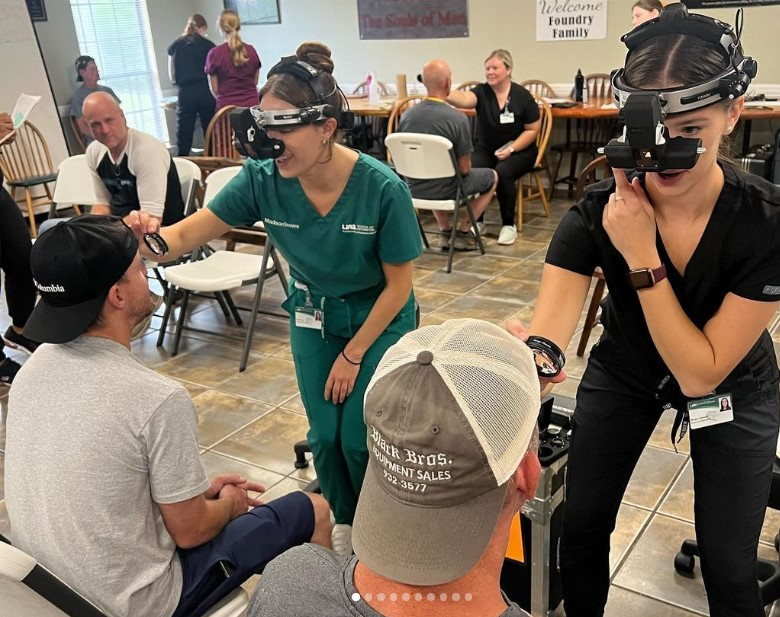
Screenshot of https://www.instagram.com/p/CxbogkwRxCC/?img_index=1 Video by UAB School of Optometry












